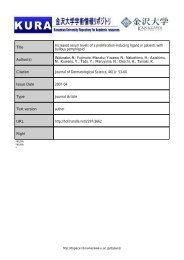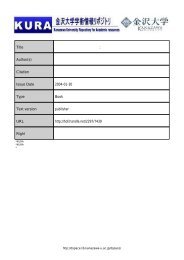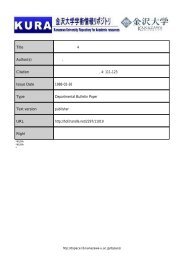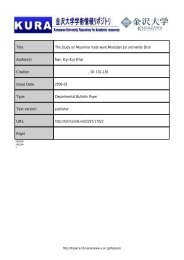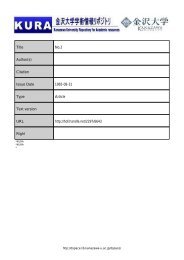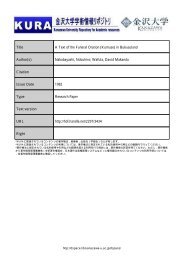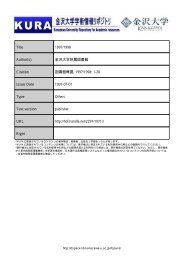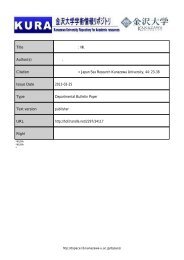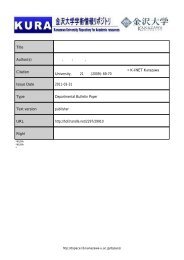Petrology of the Yugu peridotites in the Gyeonggi Massif, South Korea
Petrology of the Yugu peridotites in the Gyeonggi Massif, South Korea
Petrology of the Yugu peridotites in the Gyeonggi Massif, South Korea
You also want an ePaper? Increase the reach of your titles
YUMPU automatically turns print PDFs into web optimized ePapers that Google loves.
1989). Several isolated ultramafic bodies are distributed<br />
<strong>in</strong> <strong>the</strong> southwestern part <strong>of</strong> <strong>the</strong> <strong>Gyeonggi</strong><br />
<strong>Massif</strong> (Cheongyang and Hongseong areas), close<br />
to <strong>the</strong> Gongju Fault (Wee et al. 1994; Oh et al. 2005;<br />
Seo et al. 2005; Kim et al. 2006). Their trend is<br />
parallel to <strong>the</strong> NNE-trend<strong>in</strong>g faults, dom<strong>in</strong>antly<br />
developed <strong>in</strong> that part <strong>of</strong> <strong>the</strong> <strong>Gyeonggi</strong> <strong>Massif</strong><br />
(Woo et al. 1991; Wee et al. 1994; Yun et al. 1994).<br />
The Baekdong body is, however, elongated WNW–<br />
ESE, be<strong>in</strong>g discordant to o<strong>the</strong>r bodies (Seo et al.<br />
2005). The peridotite body <strong>in</strong> <strong>the</strong> <strong>Yugu</strong> area is <strong>the</strong><br />
largest and has a horseshoe shape (Fig. 1).<br />
The study area mostly comprises <strong>the</strong> Precambrian<br />
<strong>Yugu</strong> gneiss and m<strong>in</strong>or age-unknown<br />
metasedimentary rocks and ultramafic rocks<br />
(Fig. 1B). The <strong>Yugu</strong> gneiss was first named as <strong>the</strong><br />
<strong>Yugu</strong> granitic gneiss <strong>of</strong> Jurassic age (Um & Lee<br />
1963), but was renamed as <strong>the</strong> Precambrian <strong>Yugu</strong><br />
gneiss by <strong>the</strong> Geological and M<strong>in</strong>eralogical Institute<br />
<strong>of</strong> <strong>Korea</strong> (1973) and Kang and Lim (1974). The<br />
<strong>Yugu</strong> gneiss was dated to be 2150 20 Ma (Lee<br />
et al. 1973) or, more recently, ca 1863 Ma by<br />
sensitive high mass-resolution ion microprobe<br />
(SHRIMP) zircon age (Kim et al. 2006). It is composed<br />
<strong>of</strong> banded and augen structured biotite<br />
gneisses, which show gradational variation<br />
between <strong>the</strong>m. It comprises quartz, plagioclase,<br />
alkali feldspar, biotite, amphibole, garnet, and<br />
chlorite with m<strong>in</strong>or sillimanite, apatite, and magnetite.<br />
The <strong>Yugu</strong> gneiss is <strong>in</strong>terpreted to have<br />
experienced regional metamorphism <strong>of</strong> greenschist<br />
to amphibolite facies (Chi & Kim 1977; Lee<br />
& Choi 1994). Regionally, it shows well-developed<br />
foliation with dom<strong>in</strong>ant N60°E strike and<br />
70–80°northwest dip (Woo et al. 1991). The foliation<br />
changes <strong>in</strong> strike and dip widely around <strong>the</strong><br />
peridotite body. The <strong>Yugu</strong> gneiss is overla<strong>in</strong><br />
uncomformably by <strong>the</strong> age-unknown metasedimentary<br />
rocks near Mount Geumgye <strong>in</strong> <strong>the</strong> nor<strong>the</strong>astern<br />
part <strong>of</strong> <strong>the</strong> study area (Fig. 1B). The<br />
metasedimentary rocks are arenaceous <strong>in</strong> nature<br />
with easily identifiable stratification, and conta<strong>in</strong><br />
some gneiss clasts. Foliation <strong>in</strong> <strong>the</strong> metasedimentary<br />
rocks strikes mostly <strong>in</strong> <strong>the</strong> east–west direction<br />
and dips to <strong>the</strong> northwest (Woo et al. 1991).<br />
They are <strong>in</strong> sharp contact with <strong>peridotites</strong>. Similar<br />
and symmetrical orientation <strong>of</strong> foliations <strong>in</strong> both<br />
<strong>the</strong> metasedimentary rocks and <strong>peridotites</strong> suggests<br />
that <strong>the</strong>y have experienced fold<strong>in</strong>g toge<strong>the</strong>r<br />
after emplacement <strong>of</strong> <strong>the</strong> peridotite body (Woo<br />
et al. 1991). <strong>South</strong> <strong>of</strong> <strong>the</strong> peridotite body <strong>the</strong> <strong>Yugu</strong><br />
gneiss was <strong>in</strong>truded by a small stock <strong>of</strong> Cretaceous<br />
aplite, which is composed <strong>of</strong> quartz, potassium<br />
feldspar, and biotite with m<strong>in</strong>or muscovite. On both<br />
Peridotites from <strong>Yugu</strong>, <strong>Korea</strong> 487<br />
<strong>the</strong> west and east sides <strong>of</strong> <strong>the</strong> peridotite body <strong>the</strong>re<br />
exist two parallel faults trend<strong>in</strong>g N5–10°E (Woo<br />
et al. 1991).<br />
The <strong>Yugu</strong> peridotite body is located at about<br />
36°37′N, 126°59′E (Fig. 1). Several narrow talcalteration<br />
zones are developed <strong>in</strong> <strong>the</strong> peridotite<br />
body. In <strong>the</strong> <strong>peridotites</strong> near Mount Geumgye, 1 to<br />
5 cm thick mafic metamorphic layers and axial<br />
plane cleavages are observed (Woo et al. 1991).<br />
The marg<strong>in</strong>al part <strong>of</strong> <strong>the</strong> peridotite body is<br />
strongly altered as it is rich <strong>in</strong> antigorite and/or<br />
talc. The core part, about 250 m across, is relatively<br />
fresh, preserv<strong>in</strong>g primary textures and<br />
some primary m<strong>in</strong>erals <strong>in</strong> <strong>peridotites</strong>. We ma<strong>in</strong>ly<br />
worked on this fresh part (Fig. 1B). Peridotites<br />
show f<strong>in</strong>e stratification or foliation due to relative<br />
abundance <strong>of</strong> oliv<strong>in</strong>e and pyroxenes on outcrops,<br />
possibly due to deformation (Fig. 2). Pyroxenerich<br />
layers stand out <strong>in</strong> relief on <strong>the</strong> outcrop relative<br />
to <strong>the</strong> oliv<strong>in</strong>e-rich part that has been<br />
selectively wea<strong>the</strong>red and has a smooth surface,<br />
form<strong>in</strong>g altoge<strong>the</strong>r <strong>the</strong> lherzolite lithology (Fig. 2).<br />
The foliation plane strikes N30 to 70°E and dips 10<br />
to 40°N. Dunitic layers with smooth and hollow<br />
surface are rarely observed. Websterites and possible<br />
harzburgites (highly serpent<strong>in</strong>ized) have<br />
been found as boulders <strong>in</strong> and around <strong>the</strong> <strong>Yugu</strong><br />
peridotite body.<br />
Metabasites associated with <strong>the</strong> Baekdong and<br />
Bibong <strong>peridotites</strong> record high-pressure metamorphism<br />
<strong>of</strong> up to eclogite facies (Oh et al. 2004,<br />
2005; Kim et al. 2006). This part <strong>of</strong> <strong>the</strong> <strong>Gyeonggi</strong><br />
<strong>Massif</strong> is considered to be <strong>the</strong> eastward extension<br />
<strong>of</strong> <strong>the</strong> Dabie–Sulu Collision Belt, where ultrahighpressure<br />
metamorphic rocks and associated<br />
Fig. 2 Photograph <strong>of</strong> a typical outcrop <strong>of</strong> <strong>the</strong> <strong>Yugu</strong> <strong>peridotites</strong> with<br />
prom<strong>in</strong>ent band<strong>in</strong>g <strong>of</strong> pyroxene-rich layers (prom<strong>in</strong>ent) and oliv<strong>in</strong>e-rich<br />
layers (hollow). The width <strong>of</strong> <strong>the</strong> white board is 30 cm.<br />
© 2008 The Authors<br />
Journal compilation © 2008 Blackwell Publish<strong>in</strong>g Asia Pty Ltd




